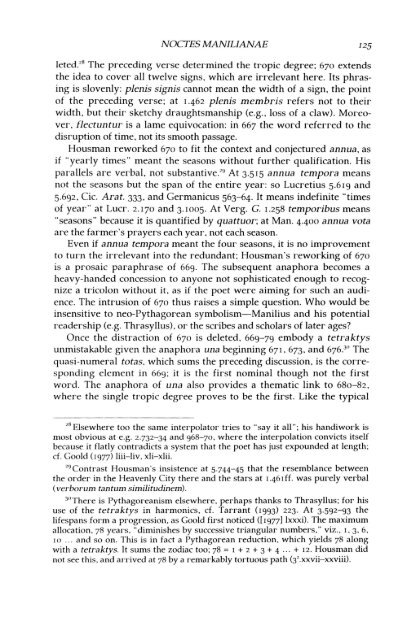MOUSEION - Memorial University of Newfoundland
MOUSEION - Memorial University of Newfoundland
MOUSEION - Memorial University of Newfoundland
Create successful ePaper yourself
Turn your PDF publications into a flip-book with our unique Google optimized e-Paper software.
NOCTES MANILIANAE 125<br />
leted. 28 The preceding verse determined the tropic degree; 670 extends<br />
the idea to cover all twelve signs. which are irrelevant here. Its phrasing<br />
is slovenly: plenis signis cannot mean the width <strong>of</strong> a sign. the point<br />
<strong>of</strong> the preceding verse; at 1.462 plenis membris refers not to their<br />
width. but their sketchy draughtsmanship (e.g.. loss <strong>of</strong> a claw). Moreover.<br />
flectuntur is a lame equivocation: in 667 the word referred to the<br />
disruption <strong>of</strong> time. not its smooth passage.<br />
Housman reworked 670 to fit the context and conjectured annua. as<br />
if "yearly times" meant the seasons without further qualification. His<br />
parallels are verbal, not substantive. 29 At 3.515 annua tempora means<br />
not the seasons but the span <strong>of</strong> the entire year: so Lucretius 5.619 and<br />
5.692. Cic. A rat. 333. and Germanicus 563-64. It means indefinite "times<br />
<strong>of</strong> year" at Lucr. 2.170 and 3.1005. At Verg. G. 1.258 temporibus means<br />
"seasons" because it is quantified by quattuor; at Man. 4.400 annua vota<br />
are the farmer's prayers each year, not each season.<br />
Even if annua tempora meant the four seasons. it is no improvement<br />
to turn the irrelevant into the redundant: Housman's reworking <strong>of</strong> 670<br />
is a prosaic paraphrase <strong>of</strong> 669. The subsequent anaphora becomes a<br />
heavy-handed concession to anyone not sophisticated enough to recognize<br />
a tricolon without it. as if the poet were aiming for such an audience.<br />
The intrusion <strong>of</strong> 670 thus raises a simple question. Who would be<br />
insensitive to neo-Pythagorean symbolism-Manilius and his potential<br />
readership (e.g. Thrasyllus). or the scribes and scholars <strong>of</strong> later ages?<br />
Once the distraction <strong>of</strong> 670 is deleted. 669-79 embody a tetraktys<br />
unmistakable given the anaphora una beginning 671. 673. and 676.3" The<br />
quasi-numeral totas. which sums the preceding discussion. is the corresponding<br />
element in 669; it is the first nominal though not the first<br />
word. The anaphora <strong>of</strong> una also provides a thematic link to 680-82.<br />
where the single tropic degree proves to be the first. Like the typical<br />
28 Elsewhere too the same interpolator tries to "say it all"; his handiwork is<br />
most obvious at e.g. 2.732-34 and 968-70. where the interpolation convicts itself<br />
because it flatly contradicts a system that the poet has just expounded at length;<br />
d. Goold (1977) !iii-liv, xli-xlii.<br />
2 9 Contrast Housman's insistence at 5.744-45 that the resemblance between<br />
the order in the Heavenly City there and the stars at I.46Iff. was purely verbal<br />
(verborum tantum similitudinem).<br />
3"There is Pythagoreanism elsewhere. perhaps thanks to Thrasyllus; for his<br />
use <strong>of</strong> the tetraktys in harmonics. d. Tarrant (1993) 223· At 3.592-93 the<br />
lifespans form a progression. as Goold first noticed ([1977] lxxxi). The maximum<br />
allocation. 78 years, "diminishes by successive triangular numbers." viz.. 1.3.6.<br />
IO ... and so on. This is in fact a Pythagorean reduction. which yields 78 along<br />
with a tetraktys. It sums the zodiac too; 78 = 1+ 2 + 3 + 4 ... + 12. Housman did<br />
not see this, and arrived at 78 by a remarkably tortuous path (32.xxvii-xxviii).

















